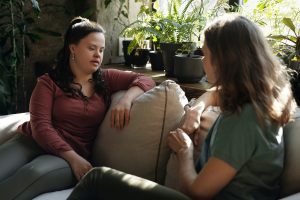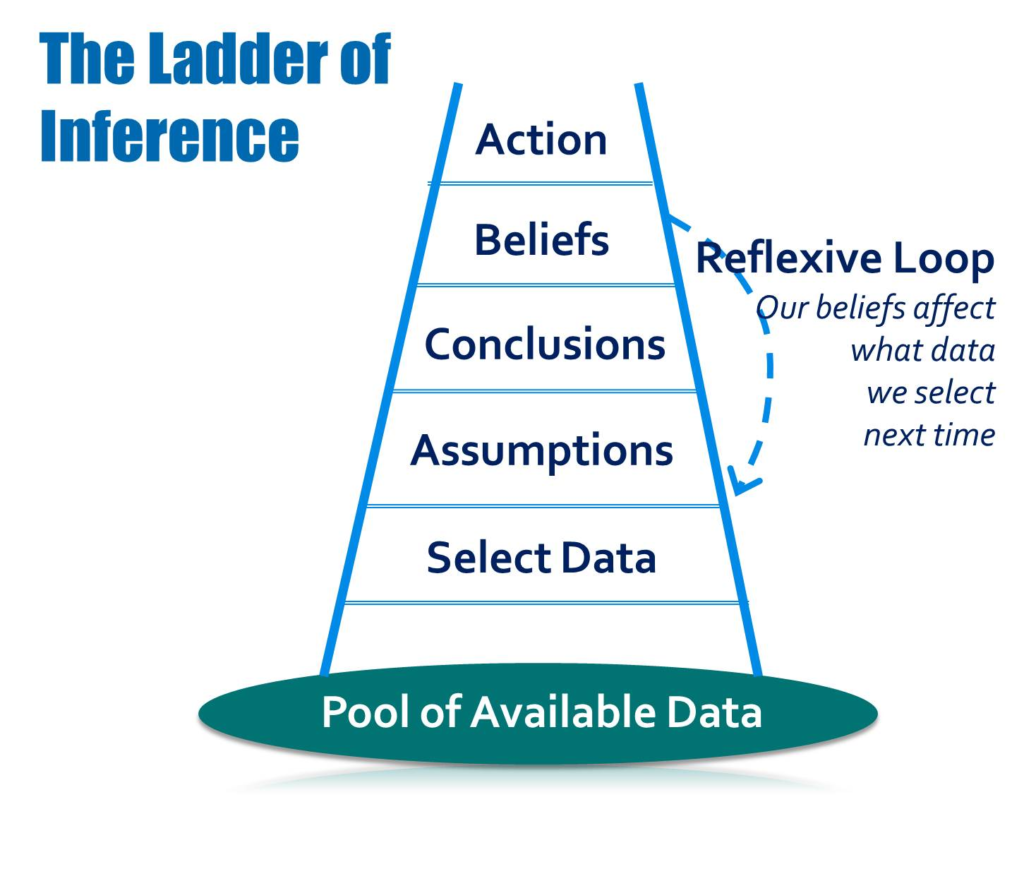Each Student to World online course includes both text-based and video-based curriculum options. Both versions have the same content, so individual students can choose the method that works best for them.
Everyday Book Covers
Each Student to World online course includes both text-based and video-based curriculum options.
Both versions have the same content, so individual students can choose the method that works best for them.

We’ve all been taught not to judge a book by its cover, and not to judge people by their outward appearance. So why do we do it anyways?
All we have when we first meet new people is their book cover, or the way they look on the outside.
The ways we react to people are a reflection of biases we have been taught.
When you meet a new person, what do you pay attention to?


![Two young girls are wearing bright and pastel colored clothes. One girl on the left is wearing a light pink hijab with a black border. The girl next to her is wearing a white hijab with light blue. They are laughing as they look at each other and hold hands. There is a man smiling behind them.]](https://gng.org/wp-content/uploads/2022/07/Two-young-girls-wearing-bright-and-pastel-colored-clothes.jpg)

- Do you look at their clothing? The color of their skin? Their facial features? Their body type? Their hair style? Their shoe size?
- Why do you think your focus goes where it goes?
- What sense do you make of these external features? What meanings do you give them?
- What have you been taught about the meanings of different clothing styles, skin colors, facial features, body types, hair style and shoe sizes?
We all have biases, which lead us to favor some people or things over others in ways that are often unfair or uninformed. From a very young age, we are taught what to think about people who are similar to and different from us. Our biases can lead us to think positively or negatively about people and groups of people before we really know them.
Selection Bias

Our biases don’t only shape how we see people, they also influence what we focus on when we meet new people. This influence is called selection bias (opens in a new window).
From all the information available to us, we select certain information over other options. When we meet someone new, we use biases even in what we select to focus on first based on what we have been taught to be meaningful information.
We might notice someone’s skin color and hair style more readily than their shoe size, because we have been taught to associate more meaning with skin color and hair style than the size of someone’s feet.
About This Course
This course was created by our unique, youth-led global internship program. Visit the course page to view learning objectives, standards alignments, content formats, and more.
Watch a Video of Module 1 Part 1
As part of Global Nomads Group’s commitment to accessibility, all Student to World video courses include American Sign Language interpretation and Closed Captioning in English and Arabic.
Key Vocabulary
Bias. (pl. biases) n. Inclinations, feelings, or opinions that affect objective judgment
Process. (pl. processes) n. A series of actions or steps taken in order to achieve a particular goal
Confirm. v. To establish the truth or correctness of (something previously believed, suspected, or feared to be the case).
Analytical. adj. Relating to or using logical reasoning.
Mental model. n. An explanation of someone’s thought process about how something works in the real world.
Influence. v. To have an effect on someone or something.
Register
Teachers, Educators, & Leaders
Create an account and invite students or youth participants.
Students
If your teacher or group facilitator gave you a code.
Independent Learners
Take a course on your own.
Already have an account?
Suday, Youth from South Africa
“I felt a bit nervous when a homeless man approached me and felt a bit annoyed, but when my father asked me a question, if I know what it is like to go to bed hungry and without a home to go to, only then did I start to self-evaluate. Then I realized that because I didn't experience what it is like to be hungry, I didn't know what that man was going through. Then only I changed my bias about poor people.”
Suday, Youth from South Africa
“I felt a bit nervous when a homeless man approached me and felt a bit annoyed, but when my father asked me a question, if I know what it is like to go to bed hungry and without a home to go to, only then did I start to self-evaluate. Then I realized that because I didn't experience what it is like to be hungry, I didn't know what that man was going through. Then only I changed my bias about poor people.”
What do you notice?
We actually get a lot of information when we first meet a new person but our brains can only process some of it. In fact, the human body sends 11 million pieces of information to the brain each second and we can only process about 50 pieces at a time. This means that as you are reading this sentence, your brain is receiving about 11 million bits of information but hasn’t even processed one percent of them.
Let’s test this out!
Take a look at this video to experiment with how your brain selects from all of the available information:
- Did you see the Gorilla? Many people don’t!
- If you did see the Gorilla, did you take the time to think about why it was there? Lots of people do not!
- Okay, okay… What about the curtain color? Did you see that it changed? Did you notice when a player from one team left the game?
Confirmation Bias
We already talked about how our brains filter information through selection bias, and experienced that bias while watching the gorilla video. We were told to focus on one thing–the ball being passed–and in selecting to focus on that, we filtered out other information, like the gorilla, the changing curtain color and the team member walking off.
But selection bias is just one way our brains make sense of our complex world. We also tend to look for information that confirms or supports what we already believe to be true. This is called confirmation bias. Confirmation bias uses our beliefs to help us focus on specific information from all the information available to us.
The problem with both selection and confirmation bias is that we miss out on a lot of important information as we only look at the things that we have been told or taught to focus on or the things that already support our beliefs.
Ladder of Inference
Do you know anyone who has a pitbull? People have a lot of opinions about this dog breed and those opinions can be based on biases. Check out this video to see how two different people use bias when they see the exact same dog:
Antonella & Ezgi discuss the Ladder of Inference. Antonella is on the left and Egzi is on the right of the screen in the image.
Did you see how Ezgi and Antonella moved from a world of available data all the way to actions?
The Ladder of Inference is an analytical tool that helps us understand how we make sense of the world, and form mental models of pitbulls, and, of course, people.

Let’s watch some global peers react to Antonella and Ezgi’s experiences with the Ladder of Inference…
Ammar, Youth from Jordan
“Last year, I met a new student in my school. He seemed very messy and poorly dressed. I thought he was such a bad, careless and messy person. Then I got to know him better from English classes. He turned out to be a very well mannered, kind, and humbled person. I came to know that he lives in a family, with poor life conditions and limited sources, and that he was putting in so much effort to ear money, in order to help his family with their financial problems. From this situation I learned not to judge people from the way they are dressed, or from their appearance. Many people now a days judge people based on standards that aren’t really fair or acceptable. Your character, manners and ethics are examples of what standards we should judge people on, and how much effort the person puts in to be special. At the end of the day, we became friends, and we got closer and closer with time. I really regret judging him without getting to know him better, that is why I will never do the same mistake again.”
Ammar, Youth from Jordan
“Last year, I met a new student in my school. He seemed very messy and poorly dressed. I thought he was such a bad, careless and messy person. Then I got to know him better from English classes. He turned out to be a very well mannered, kind, and humbled person. I came to know that he lives in a family, with poor life conditions and limited sources, and that he was putting in so much effort to ear money, in order to help his family with their financial problems. From this situation I learned not to judge people from the way they are dressed, or from their appearance. Many people now a days judge people based on standards that aren’t really fair or acceptable. Your character, manners and ethics are examples of what standards we should judge people on, and how much effort the person puts in to be special. At the end of the day, we became friends, and we got closer and closer with time. I really regret judging him without getting to know him better, that is why I will never do the same mistake again.”
Let’s move our focus to people
After reviewing some resources and stories from your global peers on the next page, you will briefly share your own story of a time when you made an assumption about someone, based on the information you chose to focus on, that you later realized was wrong.
You’ll explain how you went up the ladder of inference, selected data, made assumptions, drew conclusions, formed beliefs, and took action regarding this person. Be sure to include what you were taught that influenced your thinking and how you came to realize that your thinking was wrong.
You’re ready to explore…
Next, you’ll explore articles and videos from all over the world that help to further explain how biases form. You’ll also be able to see the stories of other young people from around the world about a time when they went up the Ladder of Inference. You can explore as many stories and resources as you’d like.
To explore stories and resources, register for this course!
Register
Teachers, Educators, & Leaders
Create an account and invite students or youth participants.
Students
If your teacher or group facilitator gave you a code.
Independent Learners
Take a course on your own.
Already have an account?
About This Course
This course was created by our unique, youth-led global internship program. Visit the course page to view learning objectives, standards alignments, content formats, and more.
Watch a Video of Module 1 Part 1
As part of Global Nomads Group’s commitment to accessibility, all Student to World video courses include American Sign Language interpretation and Closed Captioning in English and Arabic.
Key Vocabulary
Bias. (pl. biases) n. Inclinations, feelings, or opinions that affect objective judgment
Process. (pl. processes) n. A series of actions or steps taken in order to achieve a particular goal
Confirm. v. To establish the truth or correctness of (something previously believed, suspected, or feared to be the case).
Analytical. adj. Relating to or using logical reasoning.
Mental model. n. An explanation of someone’s thought process about how something works in the real world.
Influence. v. To have an effect on someone or something.
Register
Teachers, Educators, & Leaders
Create an account and invite students or youth participants.
Students
If your teacher or group facilitator gave you a code.
Independent Learners
Take a course on your own.

